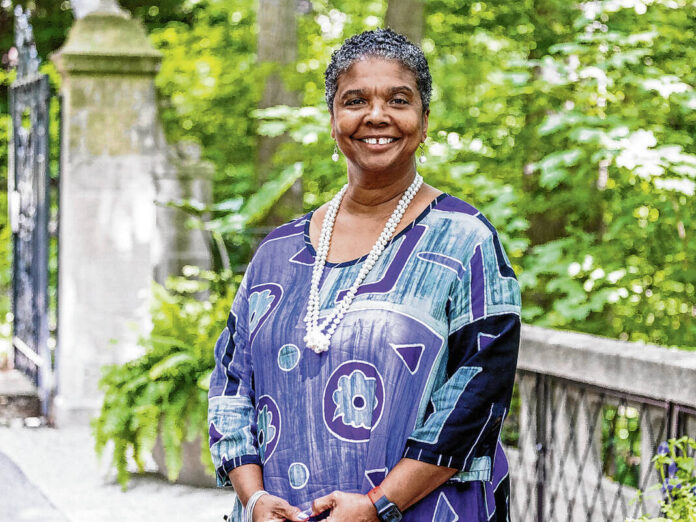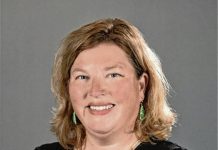
IBJ photo/Eric Learned Colette Pierce Burnette is the new president and CEO at Newfields art museum and gardens.
INDIANAPOLIS — Colette Pierce Burnette sees her hiring as the new president and CEO of Newfields as an example of the difference between equality and the more modern progress toward equity, or the practice of providing fair access and opportunities.
“I didn’t see a Black director of a large cultural institution when I was growing up,” said Pierce Burnette, who began her tenure at the art museum and gardens on Aug. 1. “I was exposed to the museum, but I didn’t see myself anywhere in the leadership or the behind-the-scenes positions. It’s very rare.
“So equality means that you can’t discriminate against putting people in those positions. Equity means that you create opportunities for those people to be in the position.”
Pierce Burnette said she likely wouldn’t have her new job without the race-related controversy that led to the February 2021 exit of her predecessor, Charles Venable. After Newfields advertised a job that described a need to attract a more diverse set of patrons while “maintaining the museum’s traditional, core, white art audience,” Venable resigned.
Most recently the CEO of Huston-Tillotson University in Austin, Texas, Pierce Burnette arrived at Newfields in time for the opening of the 139-year-old institution’s first exhibition devoted to a group of Black artists from Indiana: “We. The Culture: Works by the Eighteen Art Collective,” a show that will be on display until Sept. 24, 2023.
“That was just the beginning,” Pierce Burnette said during an IBJ interview. “It was like a crack in the door with a little sun shining through it.”
Q: During your remarks at the opening reception for “We. The Culture” on Sept. 22, you mentioned a renaissance. I think people can feel and observe the momentum of change, but how would you describe what’s happening?
A renaissance is a time of reckoning and a time of renewal, colliding all at the same time. I do believe we’re all living in a time of renaissance. And it’s a choice whether we actually make this something that will be remembered in history in a positive way or whether it’s going to be remembered in history just as a moment of pain.
I feel very strongly that we’re living in a time renaissance, and it’s personally rewarding to be at Newfields in this time in its history and the role we can play to make that renaissance be remembered. … I want it to be a time where we met this tension of a reckoning and a renewal at the same time.
Q: What does it mean for “We. The Culture” to be the first Newfields exhibition to open during your tenure as Newfields CEO?
It’s super rewarding for me because I’m at the helm of this moment of such opportunity. …
I did not live here, so I don’t know. But it’s my impression that if someone were to say, “What’s the institution in Indianapolis that opens its doors equitably to all?” people would not have said, “Newfields.”
The incident with the position description was just the spark. It’s so much deeper than that. That actually was the gift for me, from my perspective, in a bad, twisted way, like the silver lining around the cloud. Because that’s how I got here. That was the moment of pain and opportunity all in one, where it’s very painful for Newfields and the people who work here.
Q: There was a guidepost established before you were hired: It’s Newfields’ goal to be an empathetic, multicultural and anti-racist institution. What’s your assessment of how that’s going and what needs to be done?
I think it’s going well, but I think it’s going well from Aug. 1 until today. So that’s my 60-day assessment. But … I didn’t work here before.
But the reason I comfortably say I think it’s going well is because of the energy I feel here at Newfields. It’s the same kind of energy we felt (at the “We. The Culture” opening). I feel this sense of hope and this sense of belonging and engagement.
I did an exercise in my first all-staff meeting where we asked people to write down what they love about Newfields. On the other side, we asked them to write down the greatest opportunity Newfields has. And then I created a word cloud from the transcription of all of the responses. And the word “community” was by far the largest. It was all about what we can do to serve our communities.
It was all about taking the beauty of Newfields and using it to enrich people’s lives. It was people really honing in on the mission, and I was very pleased about that.
It’s so much bigger than diversity, equity, inclusion and access training. It’s about changing people’s hearts.
I want people to create public programming that’s inclusive for all—and “all” doesn’t mean exclusion of any. All means all. I want people to think through their programming because it’s the right thing to do to get us to excellence.
Ironically, people think it’s going to push us away from excellence. Actually, it does what we’re supposed to be doing, which is protecting the heritage of art—our collection, which is extraordinary—and then growing it and evolving it. …
That is so much bigger than DEIA. That’s a component of it, but I don’t want Newfields to think that we do DEIA training and then we’ve checked a box. “We’re anti-racist.” That’s unrealistic.
Q: Do you have any updates on the search for the director of the Indianapolis Museum of Art?
Yes, we’ve engaged the search firm. and I’m anticipating that we should have a public announcement out with a position description in the very near future.
We do want to do a global search because I’m in this pursuit of excellence. We have to keep the door wide open and have the perfect position description for what it is we’re looking for.
Everybody brings their A game to the interview. But we want to dig deeper and make sure that we’re not just getting A game at the interview, but that we bring someone to Newfields who’s a catalyst for excellence.
Q: Can I rewind the timeline of when you announced you were going to leave Huston-Tillotson to when this job emerged on your radar?
A friend of mine asked me to go to dinner after I had announced my retirement. During dinner, she asked me, “What are you going to do? I know you’re not going to ‘retire’ retire.” I said, “No, I’m not going to retire.
I want to do something.”
And then I was stumbling over my words, and I realized I didn’t have a plan for me. So she offered to have a colleague friend of hers sit down and have a conversation with me about what my passions were. And that person works at Korn Ferry (the consulting firm that worked with Newfields on the president and CEO search). We talked, and about two weeks later I got a phone call from a different person she had given my resume to. And she thought I would be a potential match.
I saw the Newfields description, and I said, “That’s not me.” But they were persistent in painting what Newfields was looking for. In fact, in the interviews, I kept saying, “Well, I’m an art lover, but I’m not an art aficionado.” I was doing the classic thing of talking my way out of it. That’s fear, like protecting myself from the rejection moment.
At one point, Darrianne Christian, who I think is a wonderful board chair and a wonderful human, said, “Dr. Burnette, we know what you’ve told us. We’re not looking for an art aficionado. We have a position for that. We’re looking for a leader for change.”
It makes me weepy when I think about it. That was a turning point for me because I really wanted this job.




